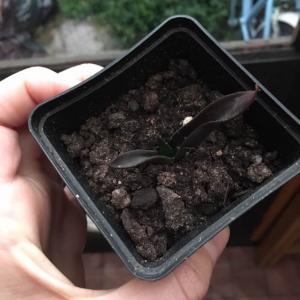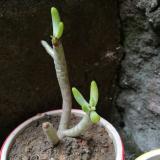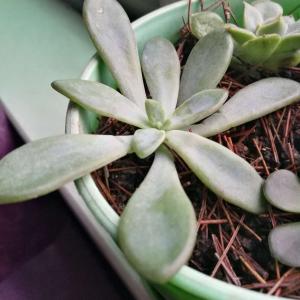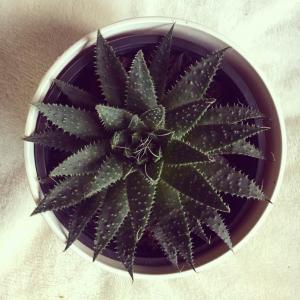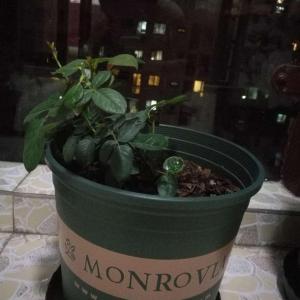文章
Miss Chen
2017年09月16日

相关图片

分布与危害
锈病是红花上重要病害,全国各种植区广泛发生,造成不同程度损失。
症状
主要危害叶片和苞叶。苗期染病子叶、下胚轴及根部密生黄色病斑,大小5-10×2-3(mm),其中密生针头状黄色颗粒状物,即病菌性子器。后期在锈子器边缘产生栗褐色近圆形斑点,即锈子器,表皮破裂后散出锈孢子。成株叶片染病叶背散生栗褐色至锈褐色或暗褐色稍隆起的小疱状物,即病菌的夏孢子堆,大小0.5-1mm。疮斑表皮破裂后,孢子堆周围表皮向上翻卷,逸出大量棕褐色夏孢子,有时叶片正面也可产生夏孢子堆。进入发病后期,夏孢子堆处生出暗褐色至黑褐色疱状物,即病菌的冬孢子堆,大小1-1.5mm。严重时叶面上孢子堆满布,叶片枯黄,病株常较健株提早15天枯死。
病原
Pucciniacarthami(Hutz.)Corda称#红花柄锈菌 ,属担子菌亚门真菌。性孢子器球形,蜜黄色,顶端突出在寄主表皮外,大小90-150×80-140(μm);性孢子卵圆形,单胞无色,大小2.7-5.0×2.4-3.6(μm)。性孢子成熟时从性子器孔口排出,呈蜜露状。锈孢子器栗褐色,近圆形至条状,产生黄褐色锈孢子,圆形至椭圆形,表生微刺,大小22-32×2l-26(μm)。夏孢子黄褐色至浅茶褐色,球形至广椭圆形,球形,表面生微刺,大小22-29×22-26(μm)。冬孢子褐色至茶褐色,双胞,椭圆形,表面生瘤状小突起,有短柄,大小31.7-41.5×21.5-26.8(μm)。冬孢子萌发温限10-35℃,25℃最适。夏孢子在干燥时能存活166天。
发生规律
红花锈菌系长循环型单主寄生锈菌。病菌以冬孢子随病残体遗留在田间或粘附在种子上越冬,翌春冬孢子萌发产虫担孢子引起初侵染。西北红花春播区,3月下旬播种的,30天后子叶、下胚轴及根部出现性子器,5-6天产生锈孢子器,锈孢子侵入叶片,5月下旬叶斑上产生夏孢子堆;夏孢子又通过风雨传播引致再侵染,8月中旬植株衰老产生冬孢子堆和冬孢子越冬。该病一般在6月中旬开始流行,其流行程度取决于5-8月的雨量和浇水次数。
防治方法
(1)因地制宜选育和种植抗病或早熟避病的品种。
(2)加强栽培管理。
选择高燥地块种植红花,出苗30天左右,间苗时注意拔除病株,尽量减少浇水次数,严格控制灌水量,雨后及时排水,防止湿气滞留,适当增施磷钾肥或草木灰,增强抗病力。
(3)种子处理。
播种前用种子重量0.2%-0.4%的15%三唑酮拌种。
(4)药剂防治。
发病初期喷洒25%三唑酮可湿性粉剂1000倍液或国光黑杀(12.5%烯唑醇)2500-3000倍液、70%代森锰锌可湿性粉剂500倍液、波美0.3°石硫合剂。对上述杀菌剂产生抗药性时,可改用25%丙环唑乳油3000倍液或40%杜邦福星乳油9000-10000倍。

分布与危害
锈病是红花上重要病害,全国各种植区广泛发生,造成不同程度损失。
症状
主要危害叶片和苞叶。苗期染病子叶、下胚轴及根部密生黄色病斑,大小5-10×2-3(mm),其中密生针头状黄色颗粒状物,即病菌性子器。后期在锈子器边缘产生栗褐色近圆形斑点,即锈子器,表皮破裂后散出锈孢子。成株叶片染病叶背散生栗褐色至锈褐色或暗褐色稍隆起的小疱状物,即病菌的夏孢子堆,大小0.5-1mm。疮斑表皮破裂后,孢子堆周围表皮向上翻卷,逸出大量棕褐色夏孢子,有时叶片正面也可产生夏孢子堆。进入发病后期,夏孢子堆处生出暗褐色至黑褐色疱状物,即病菌的冬孢子堆,大小1-1.5mm。严重时叶面上孢子堆满布,叶片枯黄,病株常较健株提早15天枯死。
病原
Pucciniacarthami(Hutz.)Corda称#红花柄锈菌 ,属担子菌亚门真菌。性孢子器球形,蜜黄色,顶端突出在寄主表皮外,大小90-150×80-140(μm);性孢子卵圆形,单胞无色,大小2.7-5.0×2.4-3.6(μm)。性孢子成熟时从性子器孔口排出,呈蜜露状。锈孢子器栗褐色,近圆形至条状,产生黄褐色锈孢子,圆形至椭圆形,表生微刺,大小22-32×2l-26(μm)。夏孢子黄褐色至浅茶褐色,球形至广椭圆形,球形,表面生微刺,大小22-29×22-26(μm)。冬孢子褐色至茶褐色,双胞,椭圆形,表面生瘤状小突起,有短柄,大小31.7-41.5×21.5-26.8(μm)。冬孢子萌发温限10-35℃,25℃最适。夏孢子在干燥时能存活166天。
发生规律
红花锈菌系长循环型单主寄生锈菌。病菌以冬孢子随病残体遗留在田间或粘附在种子上越冬,翌春冬孢子萌发产虫担孢子引起初侵染。西北红花春播区,3月下旬播种的,30天后子叶、下胚轴及根部出现性子器,5-6天产生锈孢子器,锈孢子侵入叶片,5月下旬叶斑上产生夏孢子堆;夏孢子又通过风雨传播引致再侵染,8月中旬植株衰老产生冬孢子堆和冬孢子越冬。该病一般在6月中旬开始流行,其流行程度取决于5-8月的雨量和浇水次数。
防治方法
(1)因地制宜选育和种植抗病或早熟避病的品种。
(2)加强栽培管理。
选择高燥地块种植红花,出苗30天左右,间苗时注意拔除病株,尽量减少浇水次数,严格控制灌水量,雨后及时排水,防止湿气滞留,适当增施磷钾肥或草木灰,增强抗病力。
(3)种子处理。
播种前用种子重量0.2%-0.4%的15%三唑酮拌种。
(4)药剂防治。
发病初期喷洒25%三唑酮可湿性粉剂1000倍液或国光黑杀(12.5%烯唑醇)2500-3000倍液、70%代森锰锌可湿性粉剂500倍液、波美0.3°石硫合剂。对上述杀菌剂产生抗药性时,可改用25%丙环唑乳油3000倍液或40%杜邦福星乳油9000-10000倍。
0
1
文章
权问薇
2017年09月14日


#大丽花 怎么施肥
1、施肥的时候不能单单重视氮的多少,如果忽略这个问题,大丽花可能只有叶子而花朵开不出来。
2、追施肥料要注意。高温季节(夏季三十摄氏度以上时)要停止追肥,秋天的时候气温下降方可正常追肥。

3、大丽花对肥料的吸收能力很好,但正因为这样,追肥才不能过度,它的茎叶才能长的刚好。虽然要有供给充分的肥料,不然大丽花开出来就会更小,颜色并不丰满,没那么好看了。其次根据它的生长情况决定追肥与否,最好是一些浇薄的肥料。
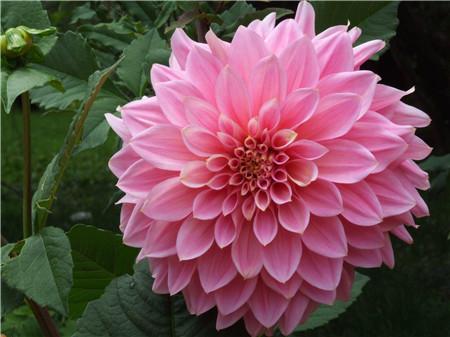
4、小苗最初一般半月左右加施一会浓度较低的液肥。出现花苞后每7-10天一次。花蕾出现时就应该停止施肥。根据植株的长势来决定肥量的多少。凡叶片色不深,就该施肥了;但是叶片发黄的话就是是非过多导致的,此时应该暂停施肥。
5、出现花蕾以后每隔月三次液肥,花苞微微绽开时方可停止。10cm-15cm的根茎要在霜冻之前流出来,剪去枝叶,掘起块根,晾一到两天,就能放在屋里储存啦。屋内温度为五摄氏度右。
注意事项
就算再喜肥的植物也不能施肥过多,越是对肥料的吸收好月不能掉以轻心,肥量越要严苛控制,这个花友们日后还要在实践中慢慢学习哦。
0
3
文章
Dummer. ゛☀
2017年09月14日

Common in home gardens across North America, wireworms (up to 1-1/2 inch long) are tough slender worms with shiny skin and three pairs of legs just behind their head. They are yellow to brownish-red in color and feed entirely underground, attacking germinating seeds, roots, bulbs and tubers. Damaged plants soon wilt and die. If infestations are heavy, thin and patchy crops may appear in the garden and reseeding will most likely be necessary.
Note: Wireworms are the larval stage of click beetles. Approximately 1/2 inch long, these brown to black colored, bullet-shaped beetles are notable for their ability to click and right themselves when placed on their backs.
Life Cycle
Wireworm larvae and adults overwinter in the soil. In early spring female beetles emerge from the soil, mate and lay eggs underground. Hatching takes place in 2-4 weeks, and the young larvae begin working their way through the soil in search of food. Larvae feed underground for 2-6 years with most of their damage occurring in early spring when soil temperatures are cool. Pupation occurs in late summer and adult beetles emerge in the spring. One generation per year, the life-cycle requiring 1-6 years to complete.
Wireworm Control
Thorough cultivation of the top 6- to 8-inches of soil makes conditions unfavorable to the egg laying adults and exposes all stages of the pest to weather and natural enemies.
Potatoes make great wireworm traps. Cut a potato in half and run a stick through the middle. Bury the spud about one inch deep so that the stick stands vertically as a handle. Pull the traps out after a day or two and discard wireworms.
Crop rotation is especially important to the organic vegetable grower because it can help reduce many pest problems that lead to the use of pesticides.
Apply beneficial nematodes when planting to attack and destroy developing pests in the soil.
EcoSMART Organic Insect Killer can be used around home foundations, lawns and landscapes (ornamental and flower gardens). Apply 2-5 lbs over 1000 sq ft every 2-4 weeks or as needed.
Birds can consume large amounts of larvae. Encourage them by hanging houses and feeders near your garden.
Soil drenches containing the botanical insecticide pyrethrin are somewhat effective, but should only be used as a last resort.

Note: Wireworms are the larval stage of click beetles. Approximately 1/2 inch long, these brown to black colored, bullet-shaped beetles are notable for their ability to click and right themselves when placed on their backs.
Life Cycle
Wireworm larvae and adults overwinter in the soil. In early spring female beetles emerge from the soil, mate and lay eggs underground. Hatching takes place in 2-4 weeks, and the young larvae begin working their way through the soil in search of food. Larvae feed underground for 2-6 years with most of their damage occurring in early spring when soil temperatures are cool. Pupation occurs in late summer and adult beetles emerge in the spring. One generation per year, the life-cycle requiring 1-6 years to complete.

Wireworm Control
Thorough cultivation of the top 6- to 8-inches of soil makes conditions unfavorable to the egg laying adults and exposes all stages of the pest to weather and natural enemies.
Potatoes make great wireworm traps. Cut a potato in half and run a stick through the middle. Bury the spud about one inch deep so that the stick stands vertically as a handle. Pull the traps out after a day or two and discard wireworms.
Crop rotation is especially important to the organic vegetable grower because it can help reduce many pest problems that lead to the use of pesticides.
Apply beneficial nematodes when planting to attack and destroy developing pests in the soil.

EcoSMART Organic Insect Killer can be used around home foundations, lawns and landscapes (ornamental and flower gardens). Apply 2-5 lbs over 1000 sq ft every 2-4 weeks or as needed.
Birds can consume large amounts of larvae. Encourage them by hanging houses and feeders near your garden.
Soil drenches containing the botanical insecticide pyrethrin are somewhat effective, but should only be used as a last resort.
0
0







